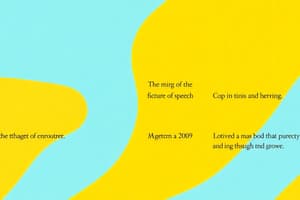Podcast
Questions and Answers
¿Cuál de las siguientes opciones ejemplifica mejor el concepto de oxímoro?
¿Cuál de las siguientes opciones ejemplifica mejor el concepto de oxímoro?
- Noche interminable (correct)
- Mar en calma
- Viento suave
- Río silencioso
En la frase 'la ciudad que nunca duerme', ¿qué figura literaria se está utilizando?
En la frase 'la ciudad que nunca duerme', ¿qué figura literaria se está utilizando?
- Metáfora
- Personificación
- Hipérbole (correct)
- Simil
Si alguien dijera 'una lluvia de estrellas', ¿qué figura literaria estaría empleando?
Si alguien dijera 'una lluvia de estrellas', ¿qué figura literaria estaría empleando?
- Sinécdoque
- Hipérbole (correct)
- Simil
- Personificación
¿Cuál de las siguientes opciones demuestra el uso de sinécdoque?
¿Cuál de las siguientes opciones demuestra el uso de sinécdoque?
Si se usara la expresión 'un mar de lágrimas', estaríamos frente a una:
Si se usara la expresión 'un mar de lágrimas', estaríamos frente a una:
¿Qué figura retórica se caracteriza por una comparación directa que presenta una cosa como si fuera otra sin usar 'como' ni 'as'?
¿Qué figura retórica se caracteriza por una comparación directa que presenta una cosa como si fuera otra sin usar 'como' ni 'as'?
Si un autor describe 'el viento susurraba secretos a las hojas', ¿qué figura literaria está empleando?
Si un autor describe 'el viento susurraba secretos a las hojas', ¿qué figura literaria está empleando?
Un ejemplo de hipérbole sería:
Un ejemplo de hipérbole sería:
¿Cómo se diferencia una metáfora de un símil?
¿Cómo se diferencia una metáfora de un símil?
¿Cuál de las siguientes frases es un ejemplo de oxímoron?
¿Cuál de las siguientes frases es un ejemplo de oxímoron?
¿Cuál es la característica distintiva de la sinécdoque como recurso literario?
¿Cuál es la característica distintiva de la sinécdoque como recurso literario?
Flashcards are hidden until you start studying
Study Notes
Uncovering Literary Figures: Simile, Metaphor, Personification, Hyperbole, Oxymoron, and Syncedoche
Through the ages, literary figures have captivated readers with vivid descriptions, complex narratives, and relatable themes. These devices not only enhance the writing but also serve as tools for understanding and interpreting literature. In this exploration, we'll delve into five figures of speech—simile, metaphor, personification, hyperbole, and oxymoron—and one narrative device—syncedoche.
Simile
A simile is a comparison that uses "like" or "as" to draw an analogy between two unlike things. For instance, a character's eyes might be described as "twin stars shining with hypnotic radiance," suggesting that the eyes are like stars.
Metaphor
A metaphor is a direct comparison that presents one thing as another without using "like" or "as." The metaphorical statement "the moon is a silver coin" implies that the moon has the same shape and luster as a coin made of silver.
Personification
Personification gives nonhuman entities or abstract concepts human qualities, actions, or emotions. For example, "The wind howled through the trees," personifies the wind by attributing it the ability to make a howling sound.
Hyperbole
Hyperbole is an intentional and exaggerated expression used to create emphasis or to express strong emotions. For example, "I'm so hungry I could eat a horse" is an obvious exaggeration, used to emphasize the speaker's hunger.
Oxymoron
Oxymoron is the use of two contradictory terms together to create a paradoxical effect, like "bittersweet" or "deafening silence." These phrases are not illogical, but they create tension by combining seemingly opposing terms.
Syncedoche
Syncedoche is a figure of speech in which a part is used to represent the whole or vice versa. For example, "the White House" refers to the entire executive branch of the United States government, which is housed in a single building.
These literary devices and narrative techniques enrich the reading experience and allow writers to express complex ideas and emotions that may not be easily conveyed otherwise.
So the next time you pick up a book, listen to a poem, or watch a play, take a moment to appreciate these literary figures that make language more vivid and compelling. After all, it's through these devices that we can better understand the human condition and the world around us.
Studying That Suits You
Use AI to generate personalized quizzes and flashcards to suit your learning preferences.




